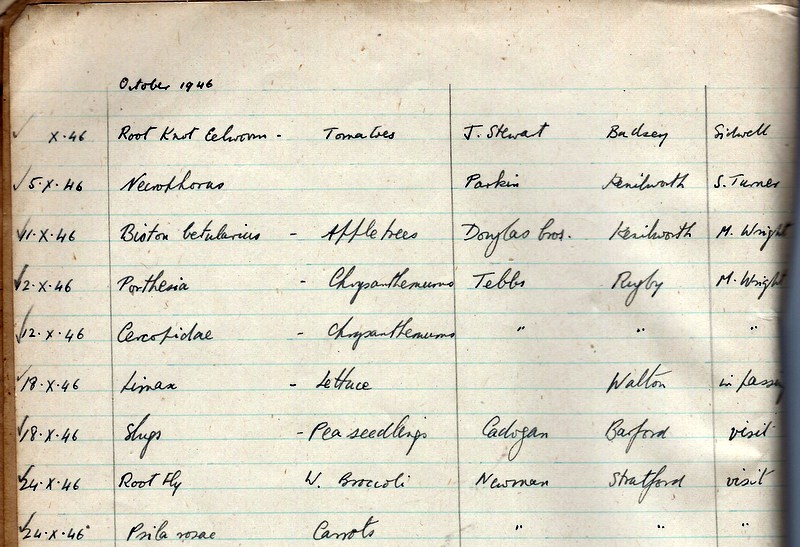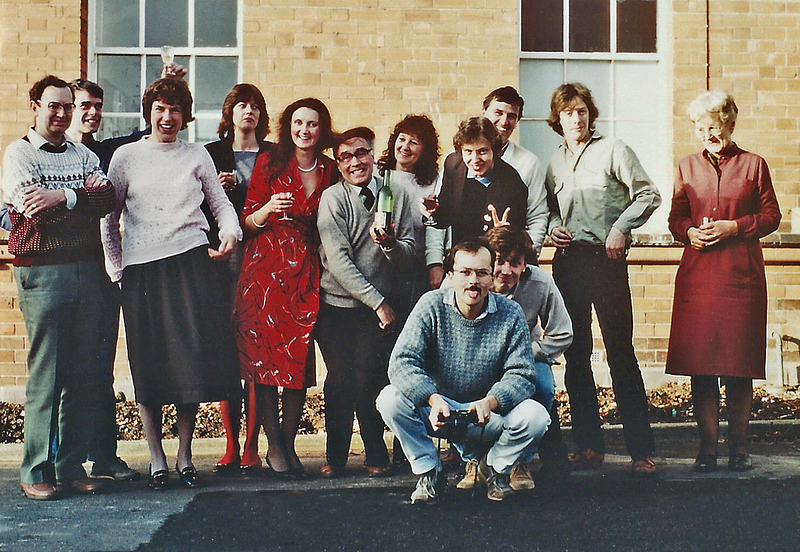The UK's National Agricultural Advisory Service (NAAS) was established in 1946 as the advisory and research arm of the Ministry of Agriculture, Fisheries and Food (MAFF), due to harsh food rationing of World War II that continued in the UK into the early 1950s. Plant pathology, entomology, soil science and other specialist advisers throughout the country advised farmers and growers how to maximise their output. The NAAS was rebranded as the Agricultural Development and Research Service (ADAS) in 1971. In 1992, ADAS became an Executive Agency of MAFF until the business was privatised in 1997.
The map below, from 1968, shows the distribution of NAAS Regional Offices and smaller centres, including the Evesham Area Laboratory.
Before the Second World War, advice to growers had been given by staff from Long Ashton Research Station, near Bristol. In 1930, an assistant to the Advisory Mycologist there spent certain periods of the year in Evesham, investigating growers’ problems. In the absence of local laboratory facilities, advisory work was, to some extent, hampered, but this position was remedied in 1941, when the Agricultural Research Council provided the first Evesham area laboratory. This was a small wooden hut in Abbey Road, as an outstation of Long Ashton. (In a 1945 aerial photograph, a building was situated in small plot where Abbey Lane joins Abbey Road and this may have been the hut in question.)
In 1946, the NAAS became responsible for providing technical advice for farmers and growers and better laboratory accommodation was provided. This was a small white prefabricated building in Henry Street that was the home of the laboratory until 1958. The rapid advances in agricultural sciences after the War led to an increased demand for technical information and eventually the facilities in the Henry Street laboratory became totally inadequate. For a while a move was postponed but the provision of additional benching and shelving could only continue for a time and by 1953, the search was begun for a new building. After a while it was decided to adapt one of the buildings that formed part of the Isolation Hospital at the end of Kings Road. Two wards of the hospital were used as laboratories by Plant Pathologists and Entomologists. The first NAAS staff in post there were Dr Alan Walker and Miss Elizabeth Schofield, Plant Pathologists, Ken Coghill, Entomologist, G.F. Chitty, Agricultural Advisor and A.W.E. Roberts, Horticultural Advisor. Until the move to Kings Road, the latter two advisors had been located at the Ministry of Agriculture office at 64 Port Street, Evesham.
 The Entomology and Plant Pathology staff kept registers of the samples examined, recording the crop, source and diagnosis. The first entries in the Entomology register, dating from October 1946, can be seen on the right. The very first entry was a sample of root knot eelworm affecting tomatoes, from a crop grown by J. Stewart in Badsey and sampled by horticultural advisor, Ron Sidwell.
The Entomology and Plant Pathology staff kept registers of the samples examined, recording the crop, source and diagnosis. The first entries in the Entomology register, dating from October 1946, can be seen on the right. The very first entry was a sample of root knot eelworm affecting tomatoes, from a crop grown by J. Stewart in Badsey and sampled by horticultural advisor, Ron Sidwell.
The NAAS and then ADAS staff soon consisted of two Plant Pathologists and two Entomologists plus scientific officers who carried out laboratory work and field trials. There were also two Horticultural Advisors who helped growers in the area. From 1972, the laboratory operated a Plant Clinic, where samples of plant pests and diseases were brought in by growers, ADAS advisors, commercial representatives and Plant Heath Advisors for examination and diagnosis of problems. Advice was given on the control of pests and diseases and field experiments were carried out to find the best methods of control. If plant diseases were caused by fungal pathogens, these could be identified on site. If it was thought that a problem was caused by bacteria, the samples were forwarded to the West Midland main laboratories at Wolverhampton to the Microbiology Department. Soil samples were also sent there to the Soil Science Department for analysis, if thought necessary to solve a crop problem. Plants with suspected virus diseases were sent to the ADAS Central Science Laboratory at Harpenden, which had electron microscopic facilities to help with identification. ADAS staff would make advisory visits to growers and farmers to help solve problems on site and give talks to grower groups and at conferences at home and abroad. A wide range of field experiments were carried out on agricultural and horticultural crops. mostly on grower’s farms and nurseries. Numerous papers were published in scientific journals as a result of these experiments.
The area covered by the scientific staff included Worcestershire, Herefordshire and Warwickshire, but some growers also came to the Plant Clinic from nearby northern Gloucestershire. In around 1980, the Evesham Area Office was expanded with the addition of more office space. The site also had glasshouses and a weather station. Testing of samples was free up until December 1985, and in the first eleven months of that year 1,740 specimens were brought into the Plant Clinic. An idea of the range of work involved can be seen from a breakdown of the sample numbers by crop type – arable crops 307; cereals 248; fruit 262; glasshouse crops 241; hardy nursery stock 255; vegetables 292; ‘miscellaneous’ 77. In 1986, the number dropped to 730 (629 chargeable and 101 non-chargeable, from MAFF Plant Health advisors). By 1988, the shock of the introduction of charging had worn off somewhat and Plant Clinic samples totalled 1,234, most of which were chargeable.
Then, as a cost-saving exercise, MAFF decided to close a number of ADAS centres in 1989 and the Evesham Area Laboratory and Evesham Area Office site in Kings Road was closed in November that year. Staff were re-deployed to other offices and laboratories.

The ADAS buildings, and other buildings in the vicinity, were eventually demolished in 2021/22 to make way for a new housing estate.
Tom Locke – April 2023
